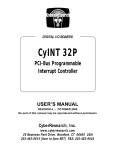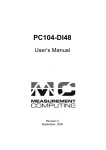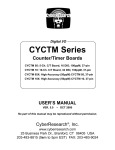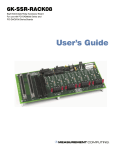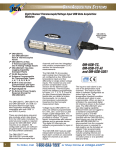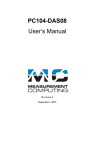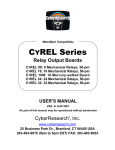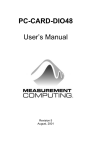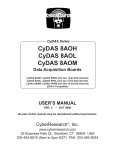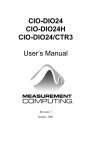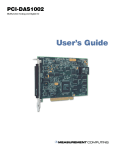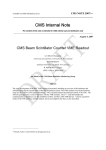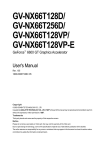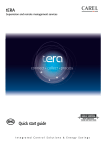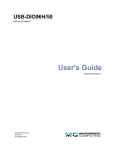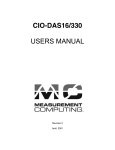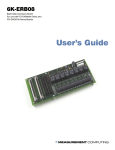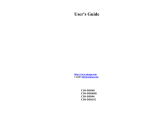Download CIO-INT-32 - Measurement Computing
Transcript
CIO-INT32 User’s Manual Revision 4 September, 2000 Your new Measurement Computing product comes with a fantastic extra — Management committed to your satisfaction! Thank you for choosing a Measurement Computing product—and congratulations! You own the finest, and you can now enjoy the protection of the most comprehensive warranties and unmatched phone tech support. It’s the embodiment of our mission: To provide data acquisition hardware and software that will save time and save money. Simple installations minimize the time between setting up your system and actually making measurements. We offer quick and simple access to outstanding live FREE technical support to help integrate MCC products into a DAQ system. Limited Lifetime Warranty: Most MCC products are covered by a limited lifetime warranty against defects in materials or workmanship for the life of the product, to the original purchaser, unless otherwise noted. Any products found to be defective in material or workmanship will be repaired, replaced with same or similar device, or refunded at MCC’s discretion. For specific information, please refer to the terms and conditions of sale. Harsh Environment Program: Any Measurement Computing product that is damaged due to misuse, or any reason, may be eligible for replacement with the same or similar device for 50% of the current list price. I/O boards face some harsh environments, some harsher than the boards are designed to withstand. Contact MCC to determine your product’s eligibility for this program. 30 Day Money-Back Guarantee: Any Measurement Computing Corporation product may be returned within 30 days of purchase for a full refund of the price paid for the product being returned. If you are not satisfied, or chose the wrong product by mistake, you do not have to keep it. These warranties are in lieu of all other warranties, expressed or implied, including any implied warranty of merchantability or fitness for a particular application. The remedies provided herein are the buyer’s sole and exclusive remedies. Neither Measurement Computing Corporation, nor its employees shall be liable for any direct or indirect, special, incidental or consequential damage arising from the use of its products, even if Measurement Computing Corporation has been notified in advance of the possibility of such damages. Trademark and Copyright Information Measurement Computing Corporation, InstaCal, Universal Library, and the Measurement Computing logo are either trademarks or registered trademarks of Measurement Computing Corporation. Refer to the Copyrights & Trademarks section on mccdaq.com/legal for more information about Measurement Computing trademarks. Other product and company names mentioned herein are trademarks or trade names of their respective companies. © 2000 Measurement Computing Corporation. All rights reserved. No part of this publication may be reproduced, stored in a retrieval system, or transmitted, in any form by any means, electronic, mechanical, by photocopying, recording, or otherwise without the prior written permission of Measurement Computing Corporation. Notice Measurement Computing Corporation does not authorize any Measurement Computing Corporation product for use in life support systems and/or devices without prior written consent from Measurement Computing Corporation. Life support devices/systems are devices or systems that, a) are intended for surgical implantation into the body, or b) support or sustain life and whose failure to perform can be reasonably expected to result in injury. Measurement Computing Corporation products are not designed with the components required, and are not subject to the testing required to ensure a level of reliability suitable for the treatment and diagnosis of people. (C) Copyright 2000 Measurement Computing Corp. HM CIO-INT32.lwp Table of Contents 1.0 INTRODUCTION . . . . . . . . . . . . . . . . . . . . . . . . . . . . . . . . . . . . . . . . . . . . . . . . 1 2.0 SOFTWARE INSTALLATION . . . . . . . . . . . . . . . . . . . . . . . . . . . . . . . . . . . . . 2 3.0 HARDWARE INSTALLATION . . . . . . . . . . . . . . . . . . . . . . . . . . . . . . . . . . . . 2 3.1 BASE ADDRESS . . . . . . . . . . . . . . . . . . . . . . . . . . . . . . . . . . . . . . . . . . . . . . . 2 3.2 INTERRUPT LEVEL SELECT . . . . . . . . . . . . . . . . . . . . . . . . . . . . . . . . . . . 3 3.3 INSTALLING THE CIO-INT32 IN THE COMPUTER . . . . . . . . . . . . . . . . . 5 3.4 CABLING TO THE CONNECTOR . . . . . . . . . . . . . . . . . . . . . . . . . . . . . . . . 6 3.5 SIGNAL CONNECTION . . . . . . . . . . . . . . . . . . . . . . . . . . . . . . . . . . . . . . . . 6 3.6 CONNECTOR DIAGRAM . . . . . . . . . . . . . . . . . . . . . . . . . . . . . . . . . . . . . . . 7 3.7 Z8536 CONTROL & DATA REGISTERS . . . . . . . . . . . . . . . . . . . . . . . . . . . 7 4.0 SPECIFICATIONS . . . . . . . . . . . . . . . . . . . . . . . . . . . . . . . . . . . . . . . . . . . . . . . 9 . . . . . . . . . . . . . . . . . . . . . . . . . . 11 5.0 ELECTRONICS AND INTERFACING 5.1 PULL UP & PULL DOWN RESISTORS . . . . . . . . . . . . . . . . . . . . . . . . . . . 11 5.2 VOLTAGE DIVIDERS . . . . . . . . . . . . . . . . . . . . . . . . . . . . . . . . . . . . . . . . . 13 5.3 LOW PASS FILTERS DE-BOUNCE INPUTS . . . . . . . . . . . . . . . . . . . . . . 15 This page is blank. 1.0 INTRODUCTION This manual provides technical information for the CIO-INT32. It is intended to be used with the ZILOG 8536 integrated circuit data sheet and programming manual. The CIO-INT32 can accept up to 32 vector interrupts and output an interrupt to the PC. The board contains two Z8536 chips each of which accepts up to 16 independent inputs that can be used to generate interrupts from bit patterns or individual bit states or transitions. The interrupt outputs from two X8536 chips can be ANDed by an on-board jumper. Many other functions can be performed by the CIO-INT32 including digital pattern recognition, counting with six, 16-bit counters, and up to 40 bits of digital I/O. The 16-bit counters can be set up independently or chained together in groups of three. The CIO-INT32 is shipped with InstaCalTM, a package of software for installation and testing of the board In addition, the board can be supported by the Universal LibraryTM which provides programming support for all Windows languages. The CIO-INT32 has a pair of Z8536 I/O chips interfaced to the ISA bus. All of its I/O lines are accessible through a 50-pin header connector. The I/O pins of an Z8536 are TTL levels. Connections to the board typically use the C50FF-# cable and the CIO-MINI50 terminal board. 1 2.0 SOFTWARE INSTALLATION In order to easily test your installation, it is recommended that you install InstaCal, the installation, calibration and test utility that was supplied with your board. Refer to the Software Installation Manual for information on the initial setup, loading, and installation of InstaCal and optional Universal Library software. 3.0 HARDWARE INSTALLATION 3.1 BASE ADDRESS The CIO-INT32 employs the PC bus for power, communications and data transfer. As such it draws power from the PC, monitors the address lines and control signals and responds to it's I/O address, and it receives and places data on the 8 data lines. If enabled, it has interrupt capability. The BASE address is the most important user selectable bus related feature of the CIO-INT32. The base address is the location that software writes to and reads from when communicating with the CIO-INT32. The base address switch is the means for setting the base address. Each switch position corresponds to one of the PC bus address lines. By placing the switch down, the CIO-INT32 address decode logic is instructed to respond to that address bit. A complete address is constructed by calculating the HEX or decimal number which corresponds to all the address bits the CIO-INT32 has been instructed to respond to. For example, shown to the right are address 9 and 8 ON, all others OFF. Address 9 = 200H (512D) and address 8 = 100H (256D), when added together they equal 300H (768D). 2 Certain address are used by the PC, others are free and may be used by the CIO-INT32 and other expansion boards. We recommend BASE = 300H (768D) be tried first. HEX RANGE 000-00F 020-021 040-043 060-063 060-064 070-071 080-08F 0A0-0A1 0A0-0AF 0C0-0DF 0F0-0FF 1F0-1FF 200-20F 210-21F 238-23B 23C-23F 270-27F 2B0-2BF Table 1. PC I/O Addresses FUNCTION HEX RANGE 8237 DMA #1 2C0-2CF 8259 PIC #1 2D0-2DF 8253 TIMER 2E0-2E7 8255 PPI (XT) 2E8-2EF 8742 CONTROLLER (AT) 2F8-2FF CMOS RAM & NMI MASK (AT) 300-30F DMA PAGE REGISTERS 310-31F 8259 PIC #2 (AT) 320-32F NMI MASK (XT) 378-37F 8237 #2 (AT) 380-38F 80287 NUMERIC CO-P (AT) 3A0-3AF HARD DISK (AT) 3B0-3BB GAME CONTROL 3BC-3BF EXPANSION UNIT (XT) 3C0-3CF BUS MOUSE 3D0-3DF ALT BUS MOUSE 3E8-3EF PARALLEL PRINTER 3F0-3F7 EGA 3F8-3FF FUNCTION EGA EGA GPIB (AT) SERIAL PORT SERIAL PORT PROTOTYPE CARD PROTOTTYPE CARD HARD DISK (XT) PARALLEL PRINTER SDLC SDLC MDA PARALLEL PRINTER EGA CGA SERIAL PORT FLOPPY DISK SERIAL PORT The CIO-INT32 BASE switch may be set for address in the range of 000-3F8 so it should not be hard to find a free address area for you CIO-INT32. Once again, if you are not using IBM prototyping cards or some other board which occupies these addresses, then 300-31F HEX are free to use. Addresses not specifically listed, such as 390-39F, are free. 3.2 INTERRUPT LEVEL SELECT If the software you are writing employs interrupt service routines, you will need to select and enable interrupts from the CIO-INT32 to the PC bus. The table below lists typical IRQ assignments. The IRQs described as UNASSIGNED are typically available to you. 3 NAME NMI IRQ0 IRQ1 IRQ2 IRQ3 IRQ4 IRQ5 IRQ6 IRQ7 Table 2. Available IRQs DESCRIPTION NAME DESCRIPTION PARITY IRQ8 REAL TIME CLOCK (AT) TIMER IRQ9 RE-DIRECTED TO IRQ2 (AT) KEYBOARD IRQ10 UNASSIGNED RESERVED (XT) IRQ11 UNASSIGNED INT 8-15 (AT) COM OR SDLC IRQ12 UNASSIGNED COM OR SDLC IRQ13 80287 NUMERIC CO-P HARD DISK (AT) IRQ14 HARD DISK LPT (AT) FLOPPY DISK IRQ15 UNASSIGNED LPT Note: IRQ8-15 are AT only The CIO-INT32 may assert interrupts either: 1. 2. 3. From an external source brought to the connector. Individually from each Z8536 for 16 external interrupt lines per chip Chained as a set of 32 interrupt lines. Choose a chained or unchained scheme by selecting chained (W) or not chained (W/O) at the INT PRIORITY jumper. Choose the source of the interrupt to be routed to the PC bus using the INT SRC jumper. If the Z8536s are chained, you must choose 1 (Chip 1 or Chip 2). 4 The interrupt output from the Z8536 or connector must be routed to the PC bus. The interrupt jumper allows you to choose a PC interrupt in the range 2 through 7. There is no information in this manual describing how to write or use an interrupt service routine. 3.3 INSTALLING THE CIO-INT32 IN THE COMPUTER Turn the power off. Remove the cover of your computer. Please be careful not to dislodge any of the cables installed on the boards in your computer as you slide the cover off. Locate an empty ISA expansion slot in your computer. Push the board firmly down into the expansion bus connector. If it is not seated fully it may fail to work and could short circuit the PC bus power onto a PC bus signal. This could damage the motherboard in your PC as well as the CIO-INT32. 3.4 CABLING TO THE CONNECTOR CIO-INT32 has a pair of Z8536 I/O chips interfaced to the PC bus, with all its I/O lines accessible through a 50 pin header connector. The I/O pins of an Z8536 are TTL level. The CIO-INT32 connector is accessible through the PC/AT expansion bracket. The connector is a standard 50 pin header connector. The C50FF-# cable and a screw terminal board, the CIO-MINI50 provide easy access for wiring to the board through 50 12-22 AWG screw terminals on a 4" X 4" terminal board. 3.5 SIGNAL CONNECTION All the digital outputs inputs on the CIO-INT32 connector are TTL. TTL is an electronics industry term, short for Transistor Transistor Logic, which describes a standard for digital signals which are either at 0V or 5V(nominal). Under normal operating conditions, the voltages on the Z8536 pins range from near 0 volts for the low state to near 5.0 volts for the high state. The current handling capability of these inputs / outputs is limited to a few milliamps. This is typical of TTL devices. 5 The voltages and currents associated with external devices range from less than a hundred mA at a few volts for a small flash light bulb to 50 Amps at 220 volts for a large electric range. Attempting to connect either of these devices directly to the CIO-INT32 would destroy the I/O chip. In addition to voltage and load matching, digital signal sources often need to be de-bounced. A complete discussion of digital interfacing will be found in the section on Interface Electronics in this manual. IMPORTANT NOTE The Z8536 digital I/O chip initializes all ports as inputs on power up and reset. A TTL input is a high impedence input. If you connect another TTL input device to the Z8536 it will probably be turned ON every time the Z8536 is reset, or, it might be turned OFF instead. Remember, and Z8536 which is reset is in INPUT mode. To safeguard against unwanted signal levels, all devices being controlled by an Z8536 should be tied low (or high, as required) by a 10K resistor. You will find positions for pull up and pull down resistor packs on your CIO-INT32 board. To implement these, please turn to the section on pull up/down resistors. 6 3.6 CONNECTOR DIAGRAM The CIO-INT32 I/O connector is a 50 pin header type connector accessible from the rear of the PC through the expansion backplate. The signals available are direct connections to a Z8536 digital I/O chip. FIRST Z8536 BASE + 0, 1, 2 INTA INTB OUT SECOND Z8536 BASE + 4, 5, 6 OUT/ If frequent changes to signal connections or signal conditioning is required, please refer to catalog information on the CIO-MINI50 screw terminal board. 3.7 Z8536 CONTROL & DATA REGISTERS Each CIO-INT32 is composed of two Z8536 parallel I/O chips. Each chip contains three data and one control register occupying four consecutive I/O locations. Complete programming and interface information is included in the Zilog Z8536 manuals. Control and output of the Z8536 chips is accomplished by I/O writes, status and inputs may be read from I/O ports. 7 The first I/O address, or BASE ADDRESS, is determined by setting a bank of switches on the board. To write to or read from a register in decimal or HEX, the following weights apply: BIT POSITION 0 1 2 3 4 5 6 7 DECIMAL VALUE 1 2 4 8 16 32 64 128 HEX VALUE 1 2 4 8 10 20 40 80 To write a control word or data to a register, the individual bits must be set to 0 or 1 then combined to form a Byte. The method of programming required to set/read bits from bytes is beyond the scope of this manual. It will be covered in most Introduction To Programming books, available from a bookstore. In summary form, the registers and their function are listed on the following table. Each register has eight bits which may constitute a byte of data or eight individual bit set/read functions. ADDRESS BASE + 0 BASE + 1 BASE + 2 BASE + 3 BASE + 4 BASE + 5 BASE + 6 BASE + 7 READ FUNCTION First Z8536 Processor Port C Input Port B Input Port A Input Status Second Z8536 Processor Port C Port B Port A Status WRITE FUNCTION Port C Output Port B Output Port A Output Control Port C Port B Port A Control Refer to the Zilog Z8536 manual for programming instructions. 8 4.0 SPECIFICATIONS Typical for 25°C unless otherwise specified. Power consumption +5V Operating 440 mA typical, 720 mA max Counter/Timer and Parallel I/O Device Output High Output Low Input High Input Low Power-up / reset state Zilog Z85C36 (2) 2.4 volts min @ -250uA 0.5 volts max @ +3.2 mA 2.0 volts min, 7 volts absolute max 0.8 volts max, -0.3 volts absolute min Input mode (high impedance) Configured as Digital Input/Output Ports: Digital Configuration 4 banks of 8 (Ports A and B), 2 banks of 4 (Port C), programmable by bit or bank as input or output Number of channels 40 I/O Configured as Counter/Timers: (Port A is a Digital I/O port only) Counter type Zilog Z85C36 Counter Configuration 6 16-bit counter/timers (Port B - High and Low nibble - and Port C) All Trigger (C1-C3 TRIG), Source (C1-C3 IN), Gate (C1-C3 GATE), and Output (C1-C3 OUT) available at user connector. Clock input frequency 3Mhz max High pulse width (clock input) 150ns min Low pulse width (clock input) 150ns min Trigger pulse width (high,low) 130ns min Interrupts: The Z8536 is programmable to generate interrupts based on bit change, pattern recognition, level or edge triggered, whether configured as a digital I/O port or counter port. See Z8536 manual for further options. Interrupts Interrupt enable Levels 2 through 7, jumper selectable (IRQ LEVEL) Jumper selectable (IRQ LEVEL) and external (INT ENABLE), active low (pulled high through resistor). 9 Interrupt sources Interrupt output Interrupt priority Jumper selectable (INT SRC): 8536A interrupt output, 8536B interrupt output, 8536A OR’ed with 8536B, external (INT INPUT, positive edge triggered) or None. Buffered output for each chip available at user connector (INTA OUT, INTB OUT). Jumper selectable (INT PRIORITY): No priority or 8536A interrupt has priority over 8536B interrupt. Environmental Operating temperature range Storage temperature range Humidity 0 to 50°C -20 to 70°C 0 to 90% non-condensing 10 5.0 ELECTRONICS AND INTERFACING This short, simple introduction to the electronics most often needed by digital I/O board users covers a few key concepts. They are: Pull up/down resistors Voltage dividers. Low pass filters for digital inputs. IMPORTANT NOTE WHEN THE Z8536 IS POWERED ON OR RESET, ALL PINS ARE SET TO HIGH IMPEDANCE INPUT. The implications of this is that if you have output devices such as solid state relays, they may be switched on whenever the computer is powered on or reset. To prevent unwanted switching and to drive all outputs to a known state after power on or reset, pull all pins either high or low through a 10K resistor. To install pull up/down resistor packs, see the following section. 5.1 PULL UP & PULL DOWN RESISTORS This discussion deals with pull-up/pull-down resistors and Z8536 digital I/O chips on CIO-INT32 boards. Whenever the Z8536 is powered on or reset, the control register is set to a known state. When used as an output device to control other TTL input devices, the Z8536 applies a voltage level of 0V for low and 2.5V to 5V for high. It is the output voltage level of the Z8536 that the device being controlled responds to. The concept of voltage level of an Z8536 in input mode is meaningless. Do not connect a volt meter to the floating input of an Z8536. It will show you nothing of meaning. In input mode the Z8536 is in 'high Z' or high impedance. If your Z8536 was connected to another input chip (the device you were controlling), the inputs of that chip are left floating whenever the Z8536 is in input mode. If the inputs of the device you are controlling are left to float, they may float up or down. Which way they float is dependent on the characteristics of the circuit and the 11 electrical environment; and unpredictable! This is why it often appears that the Z8536 has gone 'high' after power up. The result is that the controlled device gets turned on! That is why you need pull up/down resistors. Shown here is one Z8536 digital output with a pull-up resistor attached. Z8536 10K The pull-up resistor provides a reference to +5V while its value of 10,000 ohms allows very little current to flow through the circuit. If the Z8536 is reset and enters high impedance input, the line is pulled high. At that point, both the Z8536 AND the device being controlled will sense a high signal. If the Z8536 is in output mode, the Z8536 has more than enough power to over ride the pull-up resistor's high signal and drive the line to 0 volts. If the Z8536 asserts a high signal, the pull up resistor guaranties that the line goes to +5V. Of course, a pull-down resistor accomplishes the same task except that the line is pulled low when the Z8536 is reset. The Z8536 has more than enough power to drive the line high. The CIO-INT32 boards are equipped with positions for pull-up/down resistors Single Inline Packages (SIPs). The positions are marked A, B and C and are located beside the Z8536. A 10 Kohm, 8-resistor SIP has 10K resistors all connected one side to a single common point and the other, each to a pin protruding from the SIP. The common line to which all resistor are connected also protrudes from the SIP. The common line is marked with a dot and is at one end of the SIP. The SIP may be installed as pull-up or pull-down. At each location, A, B & C there are 10 holes in a line. One end of the line is +5V, the other end is GND. They are so marked. The eight holes in the middle are connected to the eight lines of the port, A, B, or C. 12 Install and solder the SIP in place. Install the SIP with the common pin (dot) in either the HI or LO hole, then solder the SIP in place. A resistor value of 10k (10000 ohms) is recommended. Use other values only if you have calculated the necessity of doing so. 5.2 VOLTAGE DIVIDERS If you wish to measure a signal which varies over a range greater than the input range of a digital input, a voltage divider can drop the voltage of the input signal to the level the digital input can measure. A voltage divider takes advantage of Ohm's law, which states, Voltage = Current * Resistance and Kirkoff's voltage law which states, The sum of the voltage drops around a circuit will be equal to the voltage drop for the entire circuit. Implied in the above is that any variation in the voltage drop for the circuit as a whole will have a proportional variation in all the voltage drops in the circuit. A voltage divider takes advantage of the fact that the voltage across one of the resistors in a circuit is proportional to the voltage across the total resistance in the circuit. 13 The trick to using a voltage divider is to choose two resistors with the proper proportions relative to the full scale of the digital input and the maximum signal voltage. The phenomena of dropping the voltage proportionally is often called attenuation. The formula for attenuation is: Attenuation = R1 + R2 R2 2 = 10K + 10K 10K R1 = (A-1) * R2 The variable Attenuation is the proportional difference between the signal voltage max and the full scale of the analog input. For example, if the signal varies between 0 and 20 volts and you wish to measure that with an analog input with a full scale range of 0 to 10 volts, the Attenuation is 2:1 or just 2. For a given attenuation, pick a handy resistor and call it R2, the use this formula to calculate R1. Digital inputs also make use of voltage dividers. For example, if you wish to measure a digital signal that is at 0 volts when off and 24 volts when on, you cannot connect that directly to the CIO-DIO digital inputs. The voltage must be dropped to 5 volts max when on. The Attenuation is 24:5 or 4.8. Use the equation above to find an appropriate R1 if R2 is 10K. Remember that a TTL input is 'on' when the input voltage is greater than 2.5 volts. IMPORTANT NOTE: The resistors, R1 and R2, are going to dissipate all the power in the divider circuit according to the equation Current = Voltage / Resistance. The higher the value of the resistance (R1 + R2) the less power dissipated by the divider circuit. Here is a simple rule: For Attenuation of 5:1 or less, no resistor should be less than 10K. For Attenuation of greater than 5:1, no resistor should be less than 1K. The CIO-TERMINAL has the circuitry on board to create custom voltage dividers. The CIO-TERMINAL is a 16" by 4" screw terminal board with two 37-pin D-type connectors and 56 screw terminals (12 - 22 AWG). Designed for table top, wall or rack mounting, the board provides prototype, divider circuit, filter circuit and pull-up resistor positions which you may complete with the proper value components for your application. 14 5.3 LOW PASS FILTERS DE-BOUNCE INPUTS A low pass filter is placed on the signal wires between a signal and an A/D board. It stops frequencies greater than the cut off frequency from entering the A/D board's analog or digital inputs. The key term in a low pass filter circuit is cut-off frequency. The cut-off frequency is that frequency above which no variation of voltage with respect to time may enter the circuit. For example, if a low pass filter had a cut off frequency of 30 Hz, the kind of interference associated with line voltage (60Hz) would be filtered out but a signal of 25Hz would be allowed to pass. Also, in a digital circuit, a low pass filter might be used to de-bounce an input from a momentary contact button pushed by a person. A low pass filter may be constructed from one resistor (R) and one capacitor (C). The cut off frequency is determined according to the formula: Fc = R= 1 2 *π* R * C Where π = 3.14... R = ohms C = Farads 1 2* π * C * Fc 15 For your notes. 16 For your notes. 17 For your notes. 18 EC Declaration of Conformity We, Measurement Computing Corp., declare under sole responsibility that the product: Part Number CIO-INT32 Description Interrupt vector board to which this declaration relates, meets the essential requirements, is in conformity with, and CE marking has been applied according to the relevant EC Directives listed below using the relevant section of the following EC standards and other normative documents: EU EMC Directive 89/336/EEC: Essential requirements relating to electromagnetic compatibility. EU 55022 Class B: Limits and methods of measurements of radio interference characteristics of information technology equipment. EN 50082-1: EC generic immunity requirements. IEC 801-2: Electrostatic discharge requirements for industrial process measurement and control equipment. IEC 801-3: Radiated electromagnetic field requirements for industrial process measurements and control equipment. IEC 801-4: Electrically fast transients for industrial process measurement and control equipment. Carl Haapaoja, Director of Quality Assurance Measurement Computing Corporation 10 Commerce Way Suite 1008 Norton, Massachusetts 02766 (508) 946-5100 Fax: (508) 946-9500 E-mail: [email protected] www.mccdaq.com
























